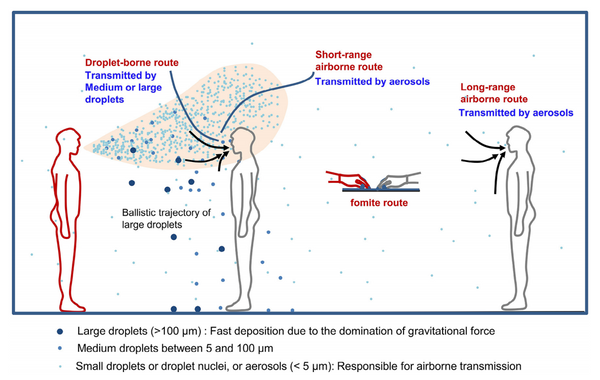What exactly is Airbourne Transmission?
While airborne transmission is not thought to be a primary route of transmission, there is an emerging and growing body of evidence that the SARS 2 CoV can also be spread through the air, particularly in poorly ventilated indoor spaces, and that ventilation provision in buildings should be reviewed in the light of this. For an explanation of airborne transmission, see the series of tweets by Prof. Lynsey Marr.
Dilution of internal air should reduce any risk of potential airborne viral transmission by reducing exposure time to any airborne viral aerosols, and also reduce the chance for these aerosols to settle on surfaces. Evidence shows that virus can survive on some surfaces for at least 72 hours and hence any action to limit surface contamination is beneficial.
If a local recirculation unit enhances air disturbance and hence helps reduce the risk of stagnant air then this should be considered when developing a strategy.
Whilst it is now spring, on colder days consideration must be given to human behavioural responses. A ventilation system on full outside air which is not adequately heated may create discomfort draughts. This may lead to users seeking to turn the system off, or with naturally ventilated spaces users may close vents or windows. These actions will reduce the air exchange rate and dilution of any contaminants (and not just any viral contamination) and overcome the primary objective of the ventilation strategy. It is important that where users can intervene in the control of the ventilation that they are made aware of the benefit of these for reducing the circulation of infectious material.
In poorly ventilated spaces with a high occupancy and where it is difficult to increase ventilation rates it may be appropriate to consider using air cleaning and disinfection devices. The most appropriate devices are likely to be local HEPA filtration units or those that use germicidal UV (GUV). GUV devices use light in the UV-C spectrum and have been shown to inactivate coronaviruses. They can be applied as an upper-room system or a stand-alone consumer unit, but it is important that these are sized correctly for the room as many do not have the flow rate to be effective in larger spaces. In-duct UV-C is not recommended to control disease transmission unless it is to decontaminate air that is recirculated. Devices that emit ozone or other potentially hazardous by-products should not be used in occupied spaces. Further guidance on air cleaning and disinfection is given in CIBSE guide A.
So how does Airborne Transmission Happen?


Areas Affected by Transmission
While airborne transmission is not thought to be a primary route of transmission, there is an emerging and growing body of evidence that the SARS-2-COV can also be spread through the air, particularly in poorly ventilated indoor spaces, and that ventilation provision in buildings should be reviewed in the light of this. For an explanation of airborne transmission, see the series of tweets by Prof. Lynsey Marr.
Dilution of internal air should reduce any risk of potential airborne viral transmission by reduction exposure time to any airborne viral aerosols, and also reduce the chance for these aerosols to settle on surfaces. Evidence shows that virus can survive on some surfaces for at least 72 hours and hence any action to limit surface contamination is beneficial.
If a local recirculation unit enhances air disturbance and hence helps reduce the risk of stagnant air then this should be considered when developing a strategy.
Whilst it is now spring, on colder days consideration must be given to human behavioural responses. A ventilation system on full outside air which is not adequately heated may create discomfort draughts. This may lead to users seeking to turn the system off.
This is where Air Purifiers such as the MAXVAC Medi 10 or MAXVAC Medi 8 come in. These are mobile units that do not rely on an outside air source. Powerful enough to create 6-12 air changes each hour, they suck air in, remove dust using multiple layers of filters incl. HEPA 13 filters so that only the bare naked virus or bacteria is left. This then passes by the powerful UVC lamp.














